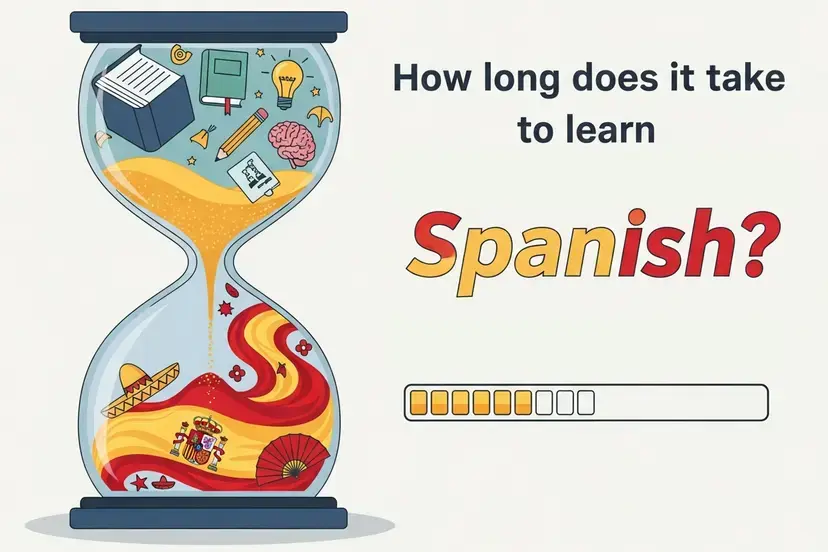
TL;DR
- Most learners need 600–750 hours to reach strong conversational Spanish, based on U.S. Foreign Service Institute (FSI) data.
- With consistent study, you can reach basic communication in 2–3 months, intermediate fluency in 6–12 months, and advanced proficiency in 1–2 years.
- Speaking early, listening daily, and immersion dramatically shorten the timeline.
- Your background and study habits matter far more than “talent.”
- Spanish is a Category I language, meaning it is among the easiest for English speakers.
How Long Does It Take to Learn Spanish?
It generally takes between 600 and 750 study hours for an English-speaking adult to learn Spanish to a strong conversational level.
This estimate comes from the Foreign Service Institute (FSI) — a U.S. government institution that trains diplomats.
(Source: Foreign Service Institute – Wikipedia)
Here’s what that looks like in real life:
- 1 hour/day → ~2 years
- 2 hours/day → ~1 year
- 3–5 hours/day → 4–8 months
- Full immersion → 2–3 months for everyday conversations
Spanish is considered a Category I language (the easiest group), thanks to its shared roots with English and straightforward pronunciation.
(Source: FSI difficulty categories – Wikipedia)
What Does “Learning Spanish” Actually Mean?
To understand the timeline, you need a clear definition of “learning Spanish.”
The CEFR (Common European Framework of Reference for Languages) is the gold-standard scale used in Europe and around the world.
(Source: Council of Europe – CEFR)
Here’s what each level looks like:
| Level | Description | Estimated Time |
|---|---|---|
| A1 (Beginner) | Can introduce yourself, use simple phrases | 1–2 months |
| A2 (Elementary) | Can shop, travel, ask for help | 2–4 months |
| B1 (Intermediate) | Can hold conversations about daily life | 4–9 months |
| B2 (Upper-Intermediate) | Can discuss opinions, stories, and work topics | 6–12+ months |
| C1 (Advanced) | Can work, study, and express nuance | 1–2+ years |
| C2 (Near-Native) | Fully comfortable with complex topics | 2–4+ years |
Your goal determines your timeline, not the other way around.
How Many Hours Does It Actually Take to Learn Spanish?
According to the Foreign Service Institute, Spanish requires 600–750 hours of study.
(Source: FSI on Wikipedia)
Many learners reach everyday conversational Spanish in 300–450 hours.
Here are realistic progress expectations:
| Daily Study | Time to B1 Conversational | Time to B2 Strong |
|---|---|---|
| 30 min/day | 9–12 months | 18–24 months |
| 1 hour/day | 6–9 months | 12–18 months |
| 2 hours/day | 3–6 months | 6–12 months |
| Immersion (5–8 hours/day) | 1–2 months | 3–6 months |
Takeaway:
Spanish fluency is a math equation: hours × consistency.
What Affects How Long It Takes to Learn Spanish?
1. Your Native Language
English speakers have a major advantage because Spanish and English share Latin roots.
(Source: Spanish language – Wikipedia)
2. Your Study Routine
Short, daily practice outperforms long weekly cram sessions.
Cognitive science research consistently supports distributed practice.
3. Speaking Early
Learners who speak from the first week reach fluency 30–40% faster due to reduced communication anxiety.
Internal link suggestions for pronunciation & speaking confidence:
- How to Pronounce Spanish Vowels: Clear Guide with Examples
- Spanish Conversation Practice: Best Tips and Tools
4. Exposure to Spanish Media
Listening to native content boosts comprehension, improves your accent, and builds automatic recognition.
Useful reading:
5. Your Goals
“Travel Spanish” is fast to learn.
”Business Spanish” and “academic Spanish” require more vocabulary and more time.
How Long Does It Take to Learn Spanish for Different Goals?
How long does it take to learn Spanish for travel?
3–8 weeks with consistent daily practice.
You only need essential verbs, greetings, food items, and direction phrases.
How long does it take to learn Spanish for conversation?
3–6 months if you combine listening, speaking, and vocabulary repetition.
How long does it take to learn workplace Spanish?
1–2 years, depending on specialization and industry vocabulary.
How long for native-like fluency?
2–4 years, according to linguistic research on the development of nuance, humor, idioms, and regional variation.
(Source: Instituto Cervantes – Annual Spanish Report)
How to Learn Spanish Faster (What Actually Works)
1. Speak From Day One
Conversation is the strongest accelerant for fluency.
Apps alone won’t get you there — speaking builds confidence.
2. Use Spaced Repetition Systems (SRS)
Spanish vocabulary has many cognates:
animal → animal, important → importante, family → familia
SRS targets your weakest words to maximize retention.
3. Listen to Spanish Every Day
Start with comprehensible input:
- Dreaming Spanish
- Easy Spanish
- Butterfly Spanish
4. Mix Structured Learning With Immersion
Use a textbook, app, or course for grammar, then reinforce with media and conversations.
5. Track Your Study Hours
Spanish fluency becomes predictable once you record your hours and keep a consistent routine.
AEO takeaway:
Fluency improves with repetition, consistency, and real-world usage.
Q&A Section
How long does it take to learn Spanish fluently?
Most learners reach solid fluency in 6–12 months of consistent study.
Is Spanish easy to learn?
Yes — it’s one of the easiest major world languages for English speakers.
(FSI Category I)
Can I learn Spanish in 3 months?
Yes, you can reach B1 conversational Spanish with intensive immersion.
How long does it take to learn Spanish by yourself?
With self-study and discipline: 6–18 months.
Does living in a Spanish-speaking country help?
Absolutely — immersion cuts the timeline by 50% or more.